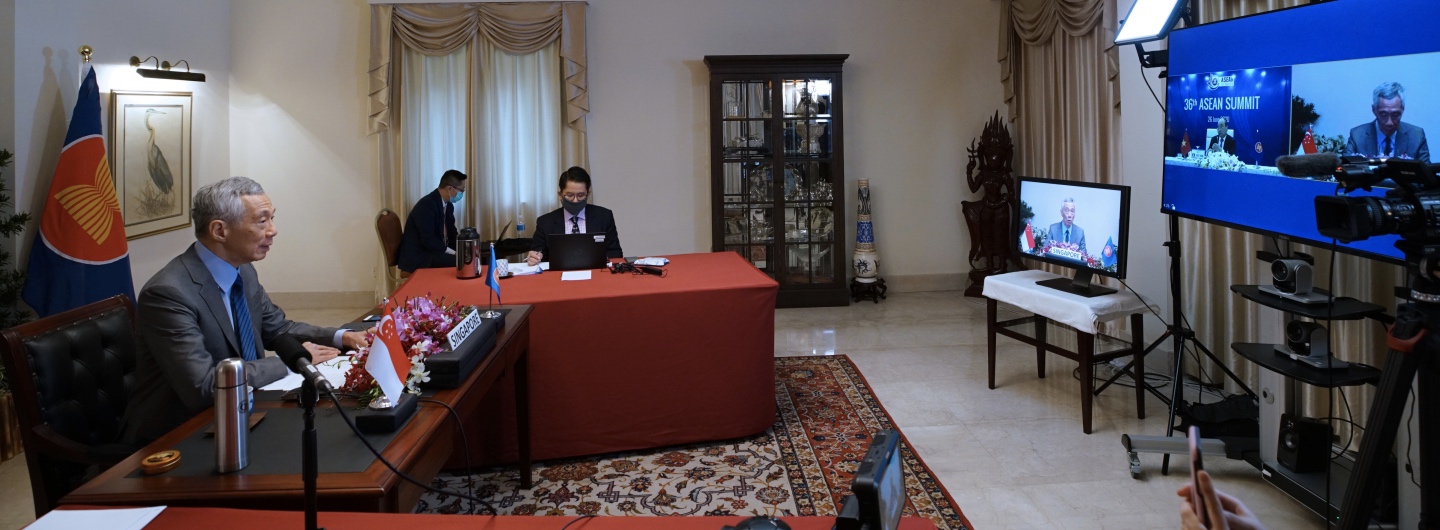Prime Minister Lee Hsien Loong, joined remotely by Minister of Foreign Affairs Vivian Balakrishnan, participated in the 36th ASEAN Summit on 26 June 2020. The Summit was convened by Vietnam, the ASEAN Chair for 2020, and was chaired by Vietnamese PM Nguyen Xuan Phuc.
Prime Minister Lee Hsien Loong, joined remotely by Minister of Foreign Affairs Vivian Balakrishnan, participated in the 36th ASEAN Summit this morning. The Summit was convened by Vietnam, the ASEAN Chair for 2020, and was chaired by Vietnamese PM Nguyen Xuan Phuc.
The opening ceremony for the Summit consisted of cultural performances courtesy of the host country Vietnam, as well as the playing of the ASEAN anthem.
At the Summit itself, Leaders of the ASEAN Member States discussed how ASEAN could continue to demonstrate cohesiveness and responsiveness during these challenging times of COVID-19 including by formulating a recovery plan, maintain ASEAN Centrality and unity amidst regional developments, as well as continue ASEAN's work in community building and addressing transboundary challenges such as climate change, haze pollution and transnational crime.
PM Lee's intervention for the 36th ASEAN Summit and Related Meetings can be found below.
*****
Your Majesty and Excellencies
I would like to thank PM Phuc for convening this Summit despite the extraordinary circumstances that we find ourselves in and I would also like to congratulate him on Vietnam’s successful management of COVID-19.
Although we are not able to meet in person, our cooperation continues uninterrupted. At our Special Summit on COVID-19 in April, we discussed several ideas to strengthen our cooperation in this new environment. I am happy to see progress on our initiatives such as the ASEAN Regional Reserve of Medical Supplies for Public Health Emergencies and the COVID-19 ASEAN Response Fund.
As we strive to get our economies back to normal, we should strengthen our cooperation and initiatives in three ways.
First, by sharing technologies that enable us to contain the pandemic and prevent future waves of infection. We can use the ASEAN Smart Cities Network to exchange ideas and experiences on using technology to fight COVID-19. For example, technology to enhance contact tracing. In Singapore, we have developed an app, TraceTogether, which uses Bluetooth signals to record those who have been in close contact with one another. We have made it an open source project, so that fellow ASEAN members and others who want to use or adapt it can do so freely. We have developed other tech solutions too, like SafeEntry, which records people entering and exiting public places. These 2 technologies allow us to identify the close contacts of confirmed COVID-19 cases quickly and quarantine them promptly.
Secondly, we should work both as a region and also with our external partners to procure an equitable, steady and affordable supply of treatments and vaccines when these have been developed and become available. Singapore is investing heavily in the research and development of diagnostics, vaccines and therapeutics. We are also building up our vaccine manufacturing capacity, so that vaccine manufacturers can use facilities in Singapore to meet the demands of the region. ASEAN countries should also explore working together to facilitate and promote cooperation on to produce and distribute vaccines. This builds upon the Declaration on ASEAN Vaccine Security and Self-Reliance last November and this will help us avoid incidental vaccine shortage and improve the supply of affordable and quality vaccines across ASEAN.
Third, we must prevent the virus from permanently damaging our economies. The economic consequences of the pandemic will linger long after the virus has been contained. Governments around the world have spent trillions of dollars to support jobs, businesses and economies but no single country can keep trade flowing alone, or international supply chains functioning by itself. Countries must work together to uphold a rules-based international trading system and maintain supply chain connectivity. ASEAN needs to show the world that we are open for business. With many countries increasingly turning inwards, an open, stable and integrated ASEAN will attract many investments to our region. We had tasked our economic ministers in April to work on preserving supply chain connectivity. I am glad that they have endorsed the Hanoi Plan of Action on Strengthening ASEAN Economic Cooperation and Supply Chain Connectivity, to take a clear stand on maintaining trade among ourselves and strengthening supply chains. We should also develop a protocol 3 to progressively and safely lift the current intra-ASEAN restrictions on travel. Singapore has begun to ease the restrictions on travellers from some countries, including ASEAN countries, and we intend to ease the restrictions further as the public health risk subsides. Such a protocol can also be a valuable guide in future public health crises. Another important piece of our regional economic architecture which started long before COVID-19 is the Regional Comprehensive Economic Partnership (RCEP). I am happy that the recent RCEP Ministerial Meeting reaffirmed the commitment of the 15 parties to sign the agreement this year. I hope we can fix the date soon. A signing of the RCEP will give a boost of confidence that will help our economic recovery.
How ASEAN countries respond to this crisis will decide whether ASEAN will forge ahead of the competition or fall behind. We must steadfastly pursue our 2025 ASEAN Community goals, including regional economic integration and cooperation on longstanding transboundary challenges such as climate change, transboundary haze pollution and transnational crime. We must also continue to strengthen ASEAN Centrality and unity. This is the way to be a safe and prosperous region, and a beacon of hope for multilateralism in these trying times. Thank you
. . . . . .
Explore recent content
Explore related topics

